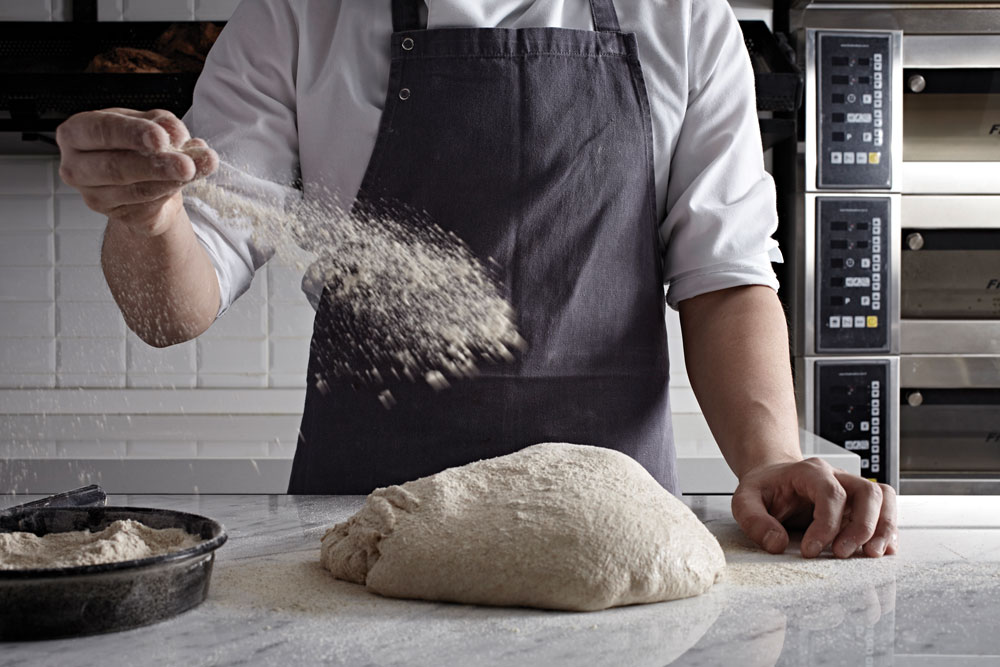Q: I’ve heard so many conflicting stories about mixing yeast with salt and sugar. Will doing this kill the yeast?
A: I can understand your confusion. That might have seemed like a cardinal rule for a long time now, but it doesn’t apply in all situations. The problem is that when wet yeast (either fresh, compressed or brick yeast), or any of the dry forms of yeast that have been hydrated/activated, are allowed to come into direct contact with salt and/or sugar, the salt/sugar has the capacity to pull the plasma material out of
the yeast, thus reducing the ability of the yeast to properly ferment the dough.
In addition to this, glutathione is a part of the plasma material pulled out of the yeast cells. Glutathione is a reducing agent, much like L-cysteine, which is the active ingredient in a common dough softener/relaxer. Glutathione is so effective at softening/relaxing the dough that it is available in dry form. Adding this to the dough increases extensibility, and it’s commonly referred to as “dead yeast.”
As you can see, there’s potential for a double whammy if the yeast is damaged by contact with salt and/or sugar. The impact of the salt or sugar on the yeast isn’t immediate, as it does take a little time for the damage to occur. Many shops have routinely mixed salt, sugar and yeast together in the water and not had a problem, while others doing this have had sporadic inconsistent dough episodes that they can’t explain.
The problem begins when the salt, sugar and yeast (in wet form only) are mixed together. In this case, the damage to the yeast happens quite quickly—only a few minutes. In cases like this, you will see the salt and sugar begin to discolor, taking on a brown hue as the yeast is dehydrated. When the salt, sugar and yeast are all mixed together in the water, it may take somewhat longer for the damage to occur, which is why the practice is so common. We might pre-stage the dough by mixing the salt, sugar and yeast into the water and allowing it to set in the bowl until we are ready to begin mixing, or we might add the flour but not mix it into the water (the flour will float on the water, leaving the underlying salt, sugar and yeast solution unaffected). This is where our problems can begin—and why there are so many conflicting stories about mixing salt, sugar and yeast together. At the very least, it adds inconsistency into our dough, so we always advise not to allow the salt, sugar and yeast to come into direct contact with each other, even when suspended/dissolved into the dough water. It just makes common sense to eliminate the potential for a problem.
When using a product like instant dry yeast (IDY), there is no problem in allowing the IDY to come into direct contact with the salt or sugar, even for extended periods of time, as long as all of the ingredients are dry. This works so well that it is a common practice in making “goodie bags,” as well as complete pizza dough mixes. Remember, though, that active dry yeast (ADY) will not work in this application, as it must be hydrated/activated in a small amount of warm water prior to use, which would take us back to the original issue of salt, sugar and yeast combining together in wet form.
Q: What temperature should my pizza dough be when I begin opening it into skins after refrigeration?
A: As we all know, dough becomes noticeably firmer when it’s cold and can be problematic to open, so we allow the dough to warm a little after removing it from the cooler. In most cases, we can go by time, but the time required should be determined by first measuring the actual dough ball temperature. Different dough formulations, as well as different shop conditions and different dough opening practices, will affect what dough ball temperature works best for each individual.
When determining the dough ball temperature, we must measure the internal dough ball temperature, as the surface temperature will not be helpful. Usually, the internal dough ball temperature will be at 40⁰F or lower when first removed from the cooler. I normally recommend allowing the dough balls to warm to an internal temperature of 50⁰F before opening them into skins. At this temperature, you should have a usable window of 2.5 to 3 hours for the dough balls (just remember to keep them covered). Note the time required to achieve this, and use it as a guide in the future.
Environment matters, too: Unusually cold shop conditions might dictate a higher internal dough temperature before opening, but a warmer shop will not usually benefit from a colder opening temperature. However, it will reduce the window of time for using the dough balls, so this will need to be taken into account when pulling dough balls from the cooler, as too many dough balls sitting out of the cooler in a hot shop will just end up overfermenting, creating problems for you.
If you happen to have a shop where you want to work with the dough as quickly as possible after being removed from the cooler, I suggest preopening the dough balls early in the day and placing them back into the cooler on screens or trays in a wire tree rack (covered) for use later in the day. When the dough is managed in this manner, all you need to do is to allow the skins to temper at room temperature for about 15 minutes, then clean them up a little by restretching to full diameter, and you’re ready to dress and bake the pizzas. Remember that hot shop I mentioned above? This is an excellent way to manage the dough under extremely warm shop conditions, or where you may not have sufficient space to store dough outside of the cooler.
Tom Lehmann is the former director of bakery assistance for the American Institute of Baking (AIB). Need more dough advice? Visit the Dough Information Center at PMQ.com/dough.















